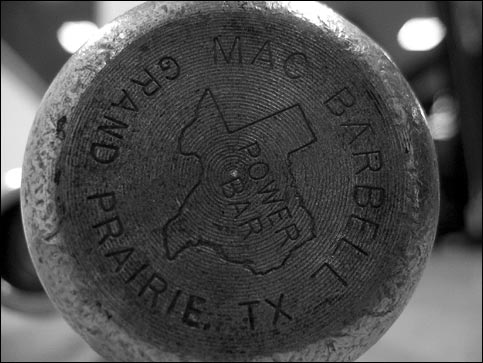June 2006 archives
June 4, 2006
Horse liniment
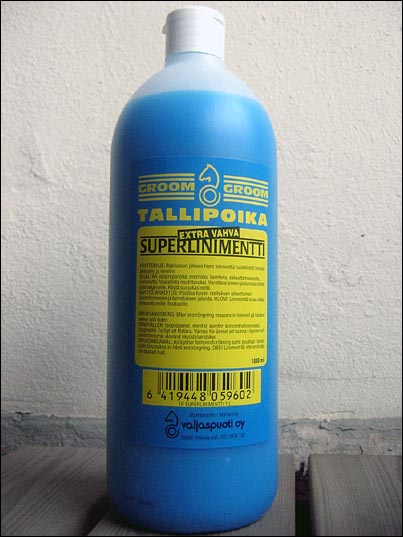
It all began when I found a thread over at Westsidebar discussing this very topic. The general party line was that normal cold liniments do not penetrate much deeper than the skin, but opinions diverged on whether the equestrian variety went much deeper to be effective. Apparently, some physical therapists recommend horse liniments precisely for this reasons, while others feel only ice delivers. Sanna also recalled that she had heard about the use of horse liniments during her massage therapy studies. Comparing the horse liniment with Ice Power and Cool Power (both common cold liniments sold here in Finland), it would appear that the active ingredients in cold liniments are some form of alcohol (isopropanol, ethanol or denatured alcohol), menthol, and possibly camphor (the horse liniment) or eucalyptus oil (Ice Power). The rest are standard cosmetic ingredients that gives the liniment its ice blue color or gel-like consistency. The horse liniment is much more runny than Ice Power, probably because it is easier to smear quickly over a large horse that way, and lacks glycerin or its equivalents.
Let me put it this way: the ingredient list (isopropanol, menthol, camphor, thickening agent and food colors) of the horse liniment I bought reveals no super potent ingredient not found in the standard cold liniments sold in pharmacies and sports departments, unless that would be camphor… If the horse liniment is more effective it is because it has higher concentrations of active ingredients than the human intended brands. The major reason, besides the possibility that it is indeed a tad more potent, to mess around with horse liniments would appear to be price. I paid 9 euros for a liter of horse liniment from the equestrian section of a local supermarket whereas the liter price of Ice Power is 50 euros if bought in the biggest container. Think about that for a second. Thomas Deebel pretty much summed it up when he was asked why EliteFTS only sell veterinary liniments:
The vet products are actually cheaper for you to purchase. The liniments I have to sell in my office are actually about the same, but cost 4X as much money.
There you have it. Sorry for dissolving the mystique surrounding the powerlifter as a mighty horse.
June 8, 2006
June 15, 2006
Week 20: Bench overhaul
Wednesday, 17 May 2006: Bench
I have spent a good deal of time analyzing and honing my benching technique, but results have hung around 100 kg/220 lbs for longer than I care to remember. My sticking point has always been about midway, right where the weight is transferred from the pecs to the deltoids. The obvious conclusion is that I need stronger delts.
The less obvious conclusion is that there might be ways of altering my benching form to give better leverage to the delts. Eons ago, it was suggested to me that allowing the bar to drift back towards the head and flaring the elbows could help me overcome my sticking point; at that time I shrugged it off because I didn’t feel ready to radically mess with the straight-line tucked elbows style I had worked so hard on. The circle finally closed as I was watching the NASA (Natural Athlete Strength Association) DVD Monster Bench Press & Monster Bench Press Assistance Program the other day. On that tape, Rich Peters states that nine times out of ten, people who miss their lift in a meet miss it right at the transition from pec to deltoid. He blames this on poor bar path, namely trying to push the bar up in a straight line. Not only that, but apparently a straight bar path is also linked to sore shoulders, rotator cuff problems and the dreaded pec/deltoid tie-in tear. He advocates driving the bar back towards the eyes in a roughly 45 degree angle, something that is easy to practice with a stick resting lightly in the V of the hand as to move immediately if the bar travels into it.
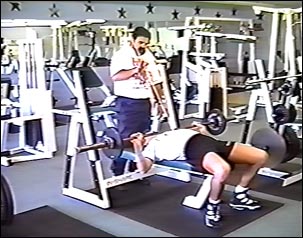
[source: N.A.S.A.Monster Bench Press & Monster Bench Press Assistance Program DVD]
That tape, transferred from VHS to DVD by Crain’s Muscle World, was apparently shot in the mid 1990s and was geared towards raw and single-ply lifters (as a sign of its time, it should be noted that the word “arch” is never mentioned on the whole tape and the discussion on bar path doesn’t go far beyond the angle of descent and ascent). Now, a decade later, letting the bar drift back towards the face while flaring the elbows out has become fashionable thanks to Bill Crawford and the Metal Militia. In fact, many Westside Barbell lifters have followed suit by ditching the hallmark Westside style of benching where the bar travels in a straight line, feet are kept wide out in front and a very moderate arch is used.There are of course several ways that the bench can be set up by manipulating the feet, arch, bar path and hand positioning variables - take for instance JM Blakley who advocates a severe arch combined with a totally straight bar path with feet retracted on the toes and using the maximum legal grip - but due to perhaps popularity and general impact, the Metal Militia and Westside Barbell styles of benching have come to symbolize polar opposite styles. Whereas the Westside/straight line benching style effectively minimizes the range of motion, the Metal Militia/tuck and flare style drives the bar more efficiently into the support of a bench shirt by taking the bar down very low while arguably providing better leverage towards the lockout. Just how different they are can be appreciated by comparing these screenshots.
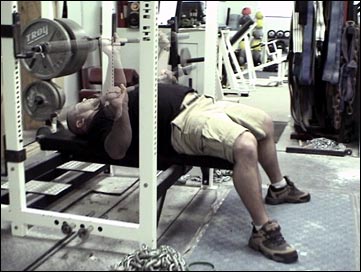
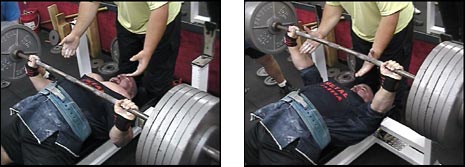
Metal Milita lifter Sebastian Burns doing his thing. [source: Advanced Bench Press DVD]
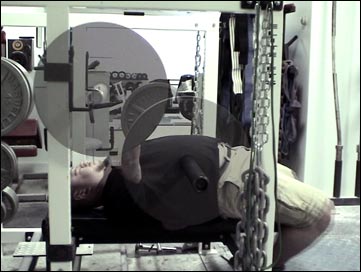
Jim Wendler in the bottom and lockout position in the Metal Militia style of benching. [source: EliteFTS Exercise Index Bench Press DVD]
In a nutshell, after slavically following the Westside straight-line benching style, I will now make the transition to a Metal Militia cum NASA inspired style. There are no guarantees that this will be a successful move. My bench will be in disarray for the next couple of months or so as I relearn my technique, but if it turns out that it gives me a leverage curve more suited to my strengths it will be more than worth it. On the other hand, if it proves to be a bad move, I can always go back to what I did before much wiser than I am now. How do you know when your bench technique is optimal? When you have tried them all, I say. Makes me wonder how many people have just concluded that the conventional or sumo deadlift style is what they are most suited for based on, say, anatomical features without actually giving both techniques a serious shot. I know I have, but now that my lower back is no longer what it should be I am forced to find out, but that’s for another entry.
Unsurprisingly, today’s workout inaugurated the laborious transition to the new style. Arching severely tends to kill my lower back, but am definitively shooting for a bit more than previously by making sure that I have both a lower and upper back arch with the weight on the upper traps as usual. I also like to keep my heels on the ground, but am bringing them in behind my knees to the position recommended on the NASA tape. Both the NASA tape and the Metal Militia DVD recommend tucking the wrists back when touching for different reasons (”controlling leverage” and “making it easier to touch with a shirt on”), but so far I am keeping my wrists straight. During the transition period, I will naturally lose some weight on the bar, but if everything goes well I should gradually build back up and beyond what I benched in the straight line style with feet out. I am also starting to set up the Metal Militia way, i.e. pulling myself up with an underhand grip towards the bar, putting the head down on the bench, retracting the shoulder blades before setting the upper back down on the bench and gripping the bar with a competition grip. Today’s video (4.9M) features a lot of technique practice and a few tricks of the trade, namely the above mentioned stick benching and Jim Wendler’s trick to find out where precisely the sweet spot to lockout is.
Standing barbell curl: worked up to 4 @ 45 kg/99 lbs
Dumbell bench: worked up to 1 @ 41 kg/90 lbs (bummer!)
Metal iso-lateral shoulder press: 6 @ 30 kg/66 lbs per side
Close-grip pulldown: 10 @ 14th (70 kg/154 lbs?)
Metal cable preacher curl: 10 @ 3 plates
Saturday, 20 May 2006: Squat
I was really confused with my stance today and had a hard time getting my squat act together. I went for a new PR, but didn’t get to the carrot.
5 @ 40 kg/88 lbs
5 @ 50 kg/110 lbs
3 @ 60 kg/132 lbs
1 @ 70 kg/154 lbs
1 @ 80 kg/176 lbs
1 @ 90 kg/198 lbs
1 @ 100 kg/220 lbs
1 @ 110 kg/242 lbs (belt on)
1 @ 120 kg/264 lbs
0 @ 125 kg/275 lbs
Dumbell step-ups on bench: 12 steps (6 per leg) @ 18.5 kg/41 lbs dumbells
2 supersets:
Seated band leg curl: 2x15 @ doubled mini
Standing cable crunch with stability ball: 2x10 @ 10th (50 kg/110 lbs?)
June 17, 2006
Week 21: Sumo deadlift baseline
Tuesday, 23 May 2006: ME Bench
Got Måns into a little behind the neck pressing challenge - figured I might have a good shot at it despite him outbenching me by some 20 kg/44 lbs. I got left in the chalk dust as he worked up to an easy enough 85 kg/187 lbs rep. 70 kg/154 lbs felt like it would go up, but I experienced some technical difficulties of an unheard magnitude. The sad truth is revealed in this week’s video summary (3M). Expended all my energy on that set and had nothing further to give.
5 @ 30 kg/66 lbs
3 @ 40 kg/88 lbs
1 @ 50 kg/110 lbs
1 @ 60 kg/132 lbs
2x0 @ 70 kg/154
0 @ 67.5 kg/149 lbs
3 @ 60 kg/132 lbs
Seated plate raise: 2x10 @ 15 kg/33 lbs
Chest supported T-bar row: 7,7,7,6 @ 60 kg/132 lbs
Reverse-grip pulldown:
5 @ 18th (90 kg/198 lbs?)
2x8 @ 16th (80 kg/176 lbs?)
Seated L-flye: 15 @ 7 kg/15 lbs dumbell
Close-grip bench, feet on bench: 10 @ 60 kg/132 lbs
Standing EZ-bar curl: 6 @ 38 kg/84 lbs
Saturday, 27 May 2006: ME Squat/Deadlift
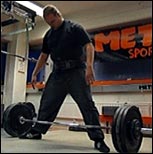 Like so many before me, I am now officially going to switch to sumo deadlifting due to recurrent back trouble which prevents me from getting away with conventional deadlifts for any length of time. I still believe the only real way to test one’s manhood (or womanhood as it may be) in the deadlift is using the conventional style, but if I am to remain in the three lift game and eventually get as far as a meet, I need to sissy out and embrace the sumo. My goal is very simple: put up a new PR (at least 150 kg/330 lbs) no later than the end of August and avoid the seriously debilitating back pain relapses that have haunted me for the last years. The pattern has always been that my back has started to feel better towards late spring and I have started to go heavy on the deadlift again, only to meet my back maker in August (2004, 2005). I have been in the game for much longer now that I have learned to avoid tons of flexion, but to date the longest period I have been able to work the deadlift is the time between the beginning of powerlifting in May 2003 and the good morning injury of December 2003. Hence my current PR, 145 kg/320 lbs set in the conventional style, dates from just before that injury. I sometimes imagine what poundages I would have on the bar had the two and a half intervening years been injury free, but I am still here and that’s all that matters.
Like so many before me, I am now officially going to switch to sumo deadlifting due to recurrent back trouble which prevents me from getting away with conventional deadlifts for any length of time. I still believe the only real way to test one’s manhood (or womanhood as it may be) in the deadlift is using the conventional style, but if I am to remain in the three lift game and eventually get as far as a meet, I need to sissy out and embrace the sumo. My goal is very simple: put up a new PR (at least 150 kg/330 lbs) no later than the end of August and avoid the seriously debilitating back pain relapses that have haunted me for the last years. The pattern has always been that my back has started to feel better towards late spring and I have started to go heavy on the deadlift again, only to meet my back maker in August (2004, 2005). I have been in the game for much longer now that I have learned to avoid tons of flexion, but to date the longest period I have been able to work the deadlift is the time between the beginning of powerlifting in May 2003 and the good morning injury of December 2003. Hence my current PR, 145 kg/320 lbs set in the conventional style, dates from just before that injury. I sometimes imagine what poundages I would have on the bar had the two and a half intervening years been injury free, but I am still here and that’s all that matters.
Today’s workout was very encouraging in light of my goal, thanks to stronger hips and legs courtesy of the recent good progress in the squat variations. I worked up to a max in the sumo style in order to get a baseline for the new program I am about to embark on. Being a sumo newbie, my technique probably leaves a lot to be desired, but I hauled 140 kg/308 lbs easily enough for me to attempt a new PR of 147.5 kg/325 lbs (that’s assuming I was using a 20 kg/44 lbs bar, haven’t weighted it). It got off the ground, but not much higher. I believe motor learning and increasing familiarity with the lift will easily put another 10 kg/22 lbs on the bar. I am thus [secretly] shooting for a PR a bit higher than 150 kg/330 lbs by the end of August. If you didn’t already catch it, you can critique my technique by watching this week’s video summary (3M). One thing is obvious though, I still have the tendency to pick it up with my back instead of driving with the legs.
several sets @ 60 kg/132 lbs to work technique
3 @ 70 kg/154 lbs
3 @ 80 kg/176 lbs
1 @ 90 kg/198 lbs
1 @ 100 kg/220 lbs
1 @ 110 kg/242 lbs
1 @ 120 kg/264 lbs
1 @ 130 kg/286 lbs
1 @ 140 kg/308 lbs
0 @ 147.5 kg/325 lbs
0 @ 142.5 kg/314 lbs
Reverse hyper: 15 @ 40 kg/88 lbs
Band crunch leaning against post: 12 @ light band
June 21, 2006
A Russian twist
Maxing out may be hard on the central nervous system (CNS) and it will sometimes play with your head, but dropping down to singles above 60% of the 1RM is not precisely hard work. If you take a look back at my workouts, you will see that my total volume of training above 80% has been low, basically consisting of singles and the occasional heavy accessory work. At this time, I think there is lots to be gained by pushing up the volume and easing up on the singles for a while. Singles will improve neural efficiency and neuromuscular coordination, vital components of maximum strength, but is too heavy to increase hypertrophy and muscular strength. This is where accessory work comes into play in Westside thinking, but rarely have I been doing enough sets and reps to really give my muscles a run for whatever money they have in spite of periodic plans to crank up the assistance volume. Right now, my technique work is also in an unprecedented state: I am working with a radically new bar path and wider grip width in the bench press, am learning the sumo style of deadlifting and am getting my raw squat act together. Putting these two factors together, it makes a lot of sense to switch to a program that has me working all the three powerlifts several times weekly (technique) with a larger volume (hypertrophy, muscular strength) than now. After considering many options, I have settled for the Extended Russian Routine (calculator) after seeing it recommended by fellow Finnish raw lifters.
The Extended Russian Routine (aka Russian Extended Peaking Cycle) consists of three workouts a week for nine weeks: day 1 is heavy bench/light squat, day 2 heavy deadlift and day 3 heavy squat/light bench (note that some people prefer to squat first on day 1 in order to duplicate the competition lift order, but I prefer to follow those who focus on the heavy lift first while fresh). It’s a standard weekly rotation over seven days with one day of rest between workouts and two days of rest before starting over. The first four weeks drive up the volume from 6 sets of 3 reps to 6 sets of 6 reps (one more rep per set per week) with the weight remaining constant at 80%. After that, the volume is decreased by one set a week on the heavy lifts while the intensity is raised by 5% every week until everything culminates at a single with 105% in all three lifts. The most challenging week to me appears to be week 8 though, where you are asked to double your PR - make that and you should have 105% in the bag. The light lifts remain constant throughout the program at 6 sets of 2 reps at 80%, but the weights are liable to feel lighter as everything else is pushed through the roof. With no deload/lightened weeks in sight, this is a rough program that leaves little room for soreness and aches, although it’s OK to occassionally skimp on the light sets if needed. This is especially challenging as the sumo deadlift hits much the same muscles as the squat. If assistance work is done, it must be brief enough not to cut into the recovery between workouts.
There you have it. Here’s my cycle based on a projected 127.5 kg/281 lbs squat max, a bench max lightened to 97.5 kg/215 lbs to take the new technique into account and a current sumo deadlift max of 140 kg/308 lbs. Successful completion would mean reaching my deadlift goal, moving up to my old bench PR in the new tuck and flare style and finally transfering that 130 kg/286 lbs parallel box squat to a free squat while laying a solid muscular ground for added strength gains. Wish me luck.
| TUESDAY | THURSDAY | SATURDAY | |
| 1 | BP: 6x3@77.5kg/171lbs (80%) SQ: 6x2@100kg/220lbs (80%) |
DL: 6x3@112.5kg/248lb (80%) | SQ: 6x3@100kg/220lbs (80%) BP: 6x2@77.5kg/171lbs (80%) |
| 2 | BP: 6x4@77.5kg/171lbs (80%) SQ: 6x2@100kg/220lbs (80%) |
DL: 6x4@112.5kg/248lbs (80%) | SQ: 6x4@100kg/220lbs (80%) BP: 6x2@77.5kg/171lbs (80%) |
| 3 | BP: 6x5@77.5kg/171lbs (80%) SQ: 6x2@100kg/220lbs (80%) |
DL: 6x5@112.5kg/248lbs (80%) | SQ: 6x5@100kg/220lbs (80%) BP: 6x2@77.5kg/171lbs (80%) |
| 4 | BP: 6x6@77.5kg/171lbs (80%) SQ: 6x2@100kg/220lbs (80%) |
DL: 6x6@112.5kg/248lbs (80%) | SQ: 6x6@100kg/220lbs (80%) BP: 6x2@77.5kg/171lbs (80%) |
| 5 | BP: 5x5@82.5kg/182lbs (85%) SQ: 6x2@100kg/220lbs (80%) |
DL: 5x5@120kg/264lbs (85%) | SQ: 5x5@107.5kg/237lbs (85%) BP: 6x2@77.5kg/171lbs (80%) |
| 6 | BP: 4x4x87.5kg/193lbs (90%) SQ:6x2@100kg/220lbs (80%) |
DL: 4x4@127.5kg/281lbs (90%) | SQ: 4x4@115kg/253lbs (90%) BP: 6x2@77.5kg/171lbs (80%) |
| 7 | BP: 3x3x92.5kg/204lbs (95%) SQ: 6x2@100kg/220lbs (80%) |
DL: 3x3@135kg/297lbs (95%) | SQ: 3x3@120kg/264lbs (95%) BP: 6x2@77.5kg/171lbs (80%) |
| 8 | BP: 2x2x97.5kg/215lbs (100%) SQ: 6x2@100kg/220lbs (80%) |
DL: 2x2@142.5kg/314lbs (100%) | SQ: 2x2@127.5kg/281lbs (100%) BP: 6x2@77.5kg/171lbs (80%) |
| 9 | BP: 1x1@102.5kg/226lbs (105%) SQ: 6x2@100kg/220lbs (80%) |
DL: 1x1@150kg/330lbs (105%) | SQ: 1x1@132.5kg/292lbs (105%) BP: 6x2@77.5kg/171lbs (80%) |
At the time of writing, I have just begun week 4. This blog is engaged in hot pursuit.
June 22, 2006
Week 22: Free bird!
Tuesday, 30 May 2006: Extended Russian Routine, week 1, day 1 (heavy bench, light squat)
An easy beginning of the Extended Russian routine, but it felt good to be doing reps with 100 kg/220 lbs, if only for doubles at these early stages. One of the main points behind embarking on the Russian routine is precisely to turn former singles weights into repping weights. Thus far, 100 kg/220 lbs has only been a single rep stop on the way up to heavier iron and I have never gone for reps. Not so long ago, it was still my squat max. Go figure.
Squat: worked up to 6x2 @ 100 kg/220 lbs
Thursday, 1 June 2006: Extended Russian Routine, week 1, day 2 (heavy deadlift)
Tuesday’s squats may have been “light”, but I was now feeling them in my legs in the form of a nagging soreness. I was also very tired as I had lost many hours of sleep preparing for the end of the school year, was feeling that in the form of a thumping headache. The reps were on the stiff side, but I got more power into my triples towards the end of the workout.
Saturday, 3 June 2006: Extended Russian Routine, week 1, day 3 (heavy squat, light bench)
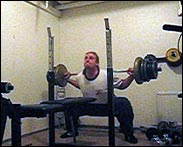 This was a very special day. Many big words were uttered, loads of flowers and farewell presents exchanged hands and BAM!… school was out and I was no longer a teacher of 22 kids in the sixth grade. The feeling was quite surreal and I know I will miss them all in spite of me having had my hands more than full on several occasions. This day was also very special because it marked the beginning of a whole new lifestyle for me, that of a stay at home dad. Sanna will return to her work as a translator in the Prime Minister’s Office on September 1st, but until then we will get to spend the whole summer together as a family. As we all know, a long and paid summer vacation is one of the main reasons teachers have more fun…
This was a very special day. Many big words were uttered, loads of flowers and farewell presents exchanged hands and BAM!… school was out and I was no longer a teacher of 22 kids in the sixth grade. The feeling was quite surreal and I know I will miss them all in spite of me having had my hands more than full on several occasions. This day was also very special because it marked the beginning of a whole new lifestyle for me, that of a stay at home dad. Sanna will return to her work as a translator in the Prime Minister’s Office on September 1st, but until then we will get to spend the whole summer together as a family. As we all know, a long and paid summer vacation is one of the main reasons teachers have more fun…
The big day nearly turned into a major setback for my training. Thinking that a bulging suit pocket doesn’t look too cool when addressing the whole school and their parents, I put my wallet on a shelf in my classroom. I even said to myself that I’ll probably forget it right there. And I did. I only noticed it when I was about to dash for the bus to Metal Gym for today’s training. Luckily, Måns had scheduled a workout at the kuntotila and graciously as always picked me up. We had to move the bench a bit to clear enough room for me to squat, but we got enough plates on the bar for my 100 kg/220 lbs squats (actually, the precise weight was 100,5 kg/221 lbs…). Had to use a bit wider grip on the bench to evade the uprights and lacked explosiveness as a result. We finished about an hour after midnight. Good workout, thanks Måns for saving my etched in stone routine!
Because training at the kuntotila is always cool, I am of course releasing a snapshot of today’s workout (VIDEO, 2.3M).
Bench (wider grip than usual): worked up to 6x2 @ 77.5 kg/171 lbs
June 24, 2006
Packed and ready for the summer!
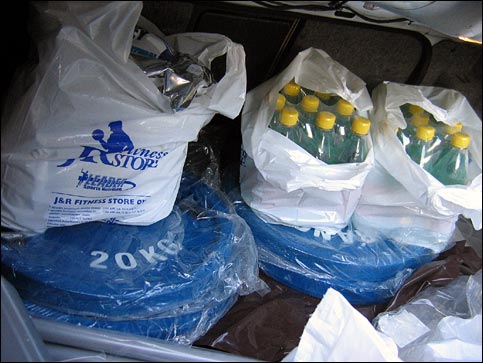
June 25, 2006
Happy with less than Excalibur
Taking a peep inside our boat shed on the mainland was one of the first, well the first, thing I did at the end of the journey up to the summer cottage. I had ordered a used Buffalo Bar several weeks earlier, but so far only dad, who picked it up for me, had seen it. There it was, but it wasn’t quite what I had bargained for. Or more to the point, it wasn’t the Ironmind Buffalo Bar I thought I had bought.
My heart sunk. Just kidding. After taking a closer look at the beast, I concluded that I had not paid 195 euros/244 dollars in vain. It was a good sturdy bar even if not as rugged as an Ironmind original, the camber was even and save for some very light surface rust (probably from its week in the shed - part of normal maintenance) and chalk stains where the previous owner had used to grip it, the bar was in pristine shape.
Compared to a standard powerlifting bar’s 125 cm/49.2″, here represented by my chrome plated generic bar that will have to go sooner or later, the Buffalo Bar is a whopping 141 cm/55.5″ between the sleeves to allow for a wide grip when squatting. This is wide enough to comfortably allow it to be gripped outside the rack uprights without risking one’s precious fingers. Interestingly enough, my version is still 8 cm/3.2″ shorter than a regular 220 cm/86.6″ bar. What gives? Obviously, the weight sleeves are shorter, 33.5 cm/13.2″ against a 42 cm/16.5″ for my regular bar. This made me alarmed at first, but after doing the math I could conclude that it is still good for between eight (my new rubber coated plates) and ten (my black iron plates) 20 kg/44 lbs plates a side, i.e. a total weight of between 340 kg/748 lbs and 420 kg/924 lbs. Unlike a normal bar, the weight sleeves are also slightly angled upwards which makes the plates stay put a lot better. The camber appears to be closer to 2″ than the 3″ of the Ironmind original, but having used the bar for a few squatting sessions now, I can attest that it is more than enough to remove ALL biceps strain even when suffering from symptoms akin to biceps tendonitis. The bar weighs around 19 kg/42 lbs, enough to call it a regular 20 kg/44 lbs bar.
The pictures below show the bar loaded with the new weight plates in the rack and compared with the regular crappy bar. The lowermost picture shows how big the camber is in practice when the bars are lying next to each other.
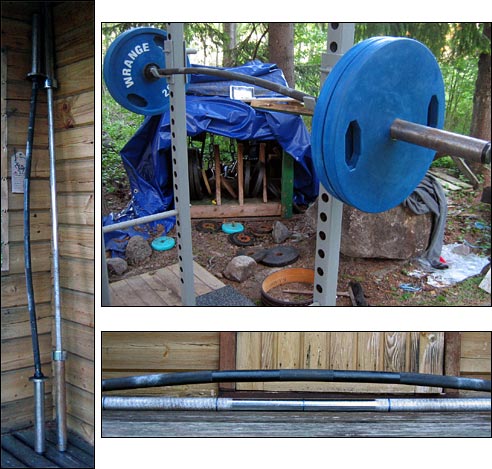
For what it’s worth, the Buffalo Bar that now graces the Voimaharjoittelu.net pages has bigger dimensions than this one, but for 200 euros/250 dollars less, I am more than content owning what must be a pretty uniquely dimensioned but well crafted Buffalo Bar. It will come to serve me and my gym visitors more than well.
June 26, 2006
Week 23: Buffalo in the wild
Tuesday, 6 June 2006: Extended Russian Routine, week 2, day 1 (heavy bench, light squat)
A painful session. Got some nasty straining kind of pain on the inside of my left biceps that only got worse as the sets progressed. It was worst at the bottom, resorted to letting the bar sink into the chest so I could get some momentary relief before pushing back up. I think this is primarily a side-effect of straining it with a wider than usual grip forced by circumstance in combination with the change of benching style and increased benching volume.
Happy to get through it and to the horse liniment.
Squat: worked up to 6x2 @ 100 kg/220 lbs
Thursday, 8 June 2006: Extended Russian Routine, week 2, day 2 (heavy deadlift)
Put some heat liniment on the left biceps an hour before the workout, about how long it takes before the heat reaches full strength. Started feeling it around the fourth set of the sumo deads, but nothing too bad. What was too bad were my hips which got very tender around the groin area, but again just gritted through it. I can’t say I’m very surprised, wide stance squatting twice a week in combination with sumo deadlifts once a week is a gruelling change of pace. The challenge now is to try to heal up the biceps and hips without having to abort the program.
Saturday, 10 June 2006: Extended Russian Routine, week 2, day 3 (heavy squat, light bench)
Yay!!! The first work of the year at Toffe’s Gym! Not much had changed in the pain department, still had a very tender groin region and lethally sore left biceps. A new addition to the list was a pinch of right knee pain caused by me pulling a 15 kg/33 lbs weight plate straight into it with some force yesterday. Was of course using the pride of Toffe’s for my squats, the new Buffalo Bar, but the biceps pain got worse. From the third set onwards, I moved my hands out all the way to the bar sleeves. Instant relief! This also caused the bar to sit even better over my back and shoulders. Thank God for the Buffalo, might not have gotten through this with a straight bar; the wider bar and camber, that puts the hands much lower than shoulder height, really helped. Skipped the light benching to give the biceps some additional healing time before next week’s heavy bench.
I’m videotaping all my lifts to check form, but will probably save you from monotony by waiting until the volume phase culminates at 6x6 @ 80% in week 4. Besides, I’m on dial-up here at the summer cottage.
